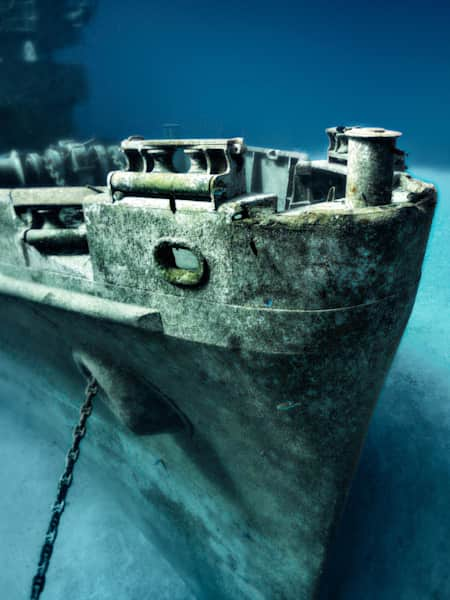There is something about a shipwreck that haunts the imagination. Maybe it's the horrifying thought of a ship going down and the loss of life entailed – or maybe it's the way once glorious vessels that sailed the oceans lie broken on the sea floor. Whatever the reason, they hold a magnetic appeal for adventurous divers and photographers. We pick some of the best to explore.
Best Wreck for Easy Access
Shipwreck: U.S.S. Kittiwake
Why: Shallow waters mean you can dive all day
Where: Cayman Islands
The ship is ideal for first time wreck explorers: Purpose sunk off Grand Cayman’s Seven Mile Beach in 2011, the 76.5m long Kittiwake was stripped clean of hazards before sinking. Doors and hatches were removed, giving each room at least one exit point.
Those with wreck diver certification cards can penetrate all five of the ship’s levels. The wheelhouse is shallowest, housing the wheel and compass. Two recompression chambers and the artificial diving bell are also highlights.
World's Largest Wreck
Shipwreck: S.S. President Coolidge
Why: Military gear, easy access, mapped routes all on offer
Where: Vanuatu
Consider the Coolidge like a ski resort. The 200m luxury-ocean-liner-turned-troop-ship has dozens of mapped routes ideal for beginners, intermediate and advanced divers. It’s the world’s largest wreck, and with beach access off the island of Espiritu Santo, Vanuatu, also among the most accessible.
Beginners should target the bow, a shallow pick at 20m. On the promenade at 33m, find rifles, gas masks and helmets. Warm up on these areas, and if you’re still not tapped out, guides can lead you on a penetration dive of the two cargo holds as well as the medical supply room.
Dive Through a Satellite Dish
Shipwreck: U.S.N.S. General Hoyt S. Vandenberg
Why: Elevator shafts you can freefall into
Where: Key West, Florida
For advanced divers, the thrill of the 158m 'Vandy' starts with a drop down one of the 11 elevator shafts, choosing any floor to enter. Those with less technical training can still freefall into the elevator and cargo shafts of this Air Force missile-tracking ship off the coast of Key West, Florida.
Downed in 2009, this artificial reef has been cleaned of hazards, and made safer with doors removed and blowtorch-added exit points. Unique to the ship are the 2m resident goliath grouper and the ship’s satellite dishes that divers pop out of following swims through the interior. Oh, and the vessel served as a set for the sci-fi flick Virus – hence the Russian lettering in the passageways.
Best Wreck for Cold Water Fans
Shipwreck: S.M.S. Coln
Why: The sense of history
Where: Scotland
“If you don’t enjoy the cold, it’s probably time for another pastime,” says Scapa Scuba dive shop instructor Kieran Hatton of the brisk waters surrounding the Scapa Flow wrecks off the Orkney Islands of Northern Scotland. Scapa Flow is the graveyard of the WW1 German Navy, which was scuttled in 1919.
His top pick for an intact vessel is the 155m-long S.M.S Coln, a German cruiser now on its starboard side in 36m of water. Why go? “You’ll see the graceful lines of an early 20th century warship,” he says, “Plus a few guns are still in place — these things are as big as your arm.”
Best Wreck for Sea Life
Shipwreck: S.S. Yongala
Why: Varied fish life make it a fascinating dive
Where: Australia
Eagle rays lay in stacks on the deck of the S.S. Yongala. Giant Queensland grouper patrol the stern. Sea snakes, turtles and clownfish also congregate on this 358-foot steamship downed by a 1911 cyclone in what is now Australia’s Great Barrier Reef Marine Park. Find it 12 nautical miles off Cape Bowling Green, Queensland. Thanks to its depth of 28m and the likelihood of a current—which helps attract schools of trevally—it is an advanced dive.
Best Wreck for WW2 Supplies
Shipwreck: S.S. Thistlegorm
Why: This merchant ship is still loaded with WW2 booty
Where: Egypt
Not for the claustrophobic, this wreck offers room after underwater room of war supplies. In 1941, two bombs sunk this British armed Merchant Navy ship in the Red Sea near Sharm el-Sheikh, Egypt. It’s a true wartime wreck still holding most of her cargo.
Divers thread overtop Bedford trucks and a fleet of Norton 16H motorcycles, keeping buoyancy so as not to brush against the rooms’ ceilings, now painted with divers’ exhaust bubbles trapped as mirror-like puddles. It’s a dive that can be as mentally taxing as it is physical: The wreck lies at a depth of 30m and the stern is tilted on its port side, making disorientation likely.
Best Wreck for Exploring at Night
Shipwreck: Shinkoku Maru
Why: Vintage tanks and rich sea life
Where: Micronesia
Enter through the torpedo blast hole, exit through the smoke stack. These are the entry instructions for swimming the engine room of Shinkoku Maru, part of the sunken fleet of Truk Lagoon in Micronesia. At 165m, it’s a warren of passageways.
Says Bob Bodkin, longtime technical diver of the destination: “You learn the ship by penetrating a little deeper each time you go.” This fleet oiler is also ideal grounds for a night dive – it’s covered in hard and soft corals and littered with the creatures, like decorator crabs, that call the wreck home.
Best Wreck for Non-Divers
Shipwreck: Eduard Bohlen
Why: Haunting reminder of the sea's power
Where: Namibia
Don't be fooled. Just because you don't have to dive doesn't make this an easy wreck to access. Says photographer Christian Ghammachi: “It is nearly impossible to reach and people usually can only fly above it. You need a license to get there and a guide in a special vehicle.”
The wreck ran aground in thick fog just south of Namibia's Skeleton coast, an infamous ships' graveyard, in 1909. It now lies about 800m inland, where the desert has encroached on the sea, a haunting reminder of man's vulnerability to the sea.











